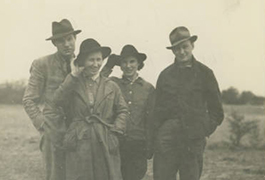
Otis and Velma Dozier, Esther & Jno. Houseman, ca. 1930s-1940s
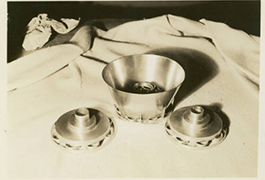
Some items made at shop, ca. 1930s
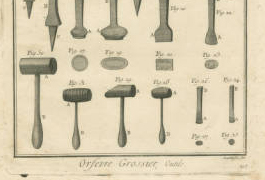
Orfevre Grossier, Outils., 1780
![The Lady Blacksmiths, Presenting their 1940-1941 Catalogue. [page 13]](/-/media/Site/Libraries/digital-collections/ewh/ewh_slideshow_catalog.jpg)
[Item from the Lady Blacksmiths'1940-1941 Catalog]
![[Esther Webb Houseman and Velma Davis Dozier with their Metalwork]](/-/media/Site/Libraries/digital-collections/ewh/ewh_slideshow_esther_velma_sombreros_sm.jpg)
[Esther Webb Houseman and Velma Davis Dozier with theirMetalwork], ca. 1930s-1940s
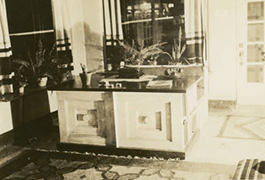
Shop on Greenville, ca. 1930s
About the Collection
Holding library: Bywaters Special Collections, Hamon Arts Library
View more collections held by Bywaters Special Collections
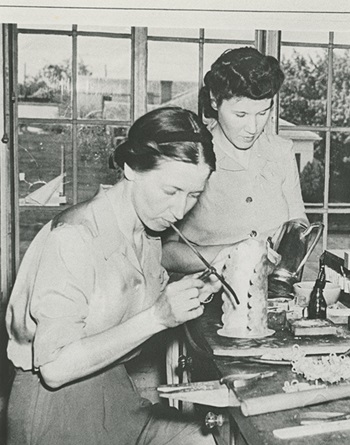
Overview
The Esther Webb Houseman Art Work and Papers
digital collection contains artwork, clippings, correspondence, documents, photographs, publicity, and published works relating to Esther’s own personal work and that of the Dallas School of Creative Arts and the Craft Guild of Dallas. The collection is housed in the Jerry Bywaters Special Collections Wing of the Hamon Arts Library. A finding aid for the collection is available in TARO.
The Life and Work of Esther Webb Houseman
Esther Webb was born in 1910 in Denver, Colorado. Her parents moved to Dallas when Esther was 1½ years old. At an early age, Esther became interested in art and took art classes at the Aunspaugh Art School in Dallas. She continued her studies in art at the College of Industrial Arts (CIA, now Texas Woman’s University) in Denton where she graduated in 1933 with a Bachelor of Science degree. While attending CIA, Esther took a metalworking class from Thetis Lemmon, herself a talented artist, and met her life-long friend and colleague, Velma Davis. While driving back and forth together from Dallas to Denton the two would talk about having their own studio and gallery space where they could do their own work at their own pace, without the disruption of a class bell.
In 1933, they opened the Dallas School of Creative Arts located at 2714 Greenville Avenue in a building owned by Velma’s father. With the help of Lynn Ford, brother of Texas architect O’Neil Ford, they learned to make their own furniture for the reception area. The first year of operation did not show much profit but Esther and Velma were determined to make their new school a success. Excellent instruction, a well-equipped classroom, and creative advertisement soon gained the attention of the Dallas community.
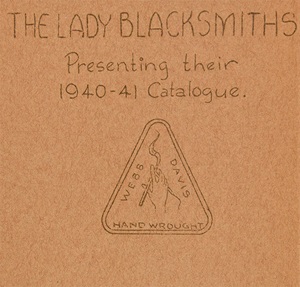
In 1934 the Dallas Times Herald reported: "Miss Velma Davis and Miss Esther Webb are two young Dallas women who have established the Dallas School of Creative Arts on Greenville Avenue, and have equipped it with one of the finest laboratories in the Southwest for the practical making of jewelry, textile designs and all sorts of hand-wrought articles in silver, copper, pewter and other metals."
In 1935, the school was moved upstairs to 2714½ Greenville Avenue, and on September 29, 1935, the Dallas School of Creative Arts held its first open house and invited the public to visit the facility, complete with laboratory and gift shop. It did not take long for the school to become a center for all sorts of activities – classes, exhibitions, parties, and in general, good times with other artists. In addition to the classes and social activities, Esther and Velma continued to do their own work. Jerry Bywaters, art critic for The Dallas Morning News, announced that they received first prize in metalwork at the first annual Dallas Decorative Arts Exhibition at the Dallas Museum of Fine Arts in 1935. In order to improve their metalworking skills and learn new techniques, Esther and Velma decided to attend the Stout Institute in Menomonie, Wisconsin in the summer of 1936. There, the otherwise all-male class, nicknamed them "The Lady Blacksmiths" – a name they would later use in advertisements for their work. Both participated in the popular Dallas Art Carnivals during the 1930s and Esther had one of her enameled boxes accepted into the 8th Annual Allied Arts Exhibition at the Dallas Museum of Fine Arts. Esther was also an active member of the Dallas Artists’ League.
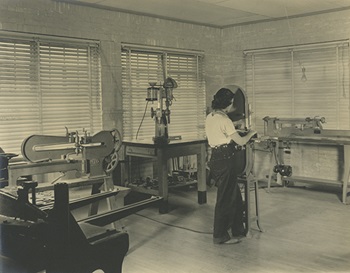
On September 25, 1939, Esther married John Houseman, a structural engineer for the Army, in Denton, Texas, at the Little Chapel-in-the-Woods. Their marriage was the first one performed in the newly constructed chapel designed by O’Neil Ford. A year later, Velma married Texas artist Otis Dozier in the Dallas School of Creative Arts. Esther and Velma decided to close their school, especially since wartime prices were making it difficult to find metals for their work. The Housemans moved to Iowa during the war years but returned to Dallas in 1945. Esther taught design at Southern Methodist University in 1947, 1949, and 1950. The Doziers also returned to Dallas in 1945 after Otis left his teaching post at the Colorado Springs Fine Arts Center. Urged by local crafts people to reopen their school, Esther and Velma decided to do so but with a new name – The Craft Guild of Dallas – a school that continues to operate today.
In 1957, Esther began working at the Dallas Museum of Fine Arts with several job assignments including that of registrar, crafts coordinator, and curator of numerous craft exhibitions. Esther’s reputation as a professional craft artist earned her the title as the South Central Regional representative of the American Craftsmen’s Council of Trustees in 1962. Though she retired from the Dallas Museum of Fine Arts in 1975, Esther continued to work as an adjunct exhibition curator at the museum until her health began to decline. In 1979 she assisted with the blockbuster exhibition, Pompeii, A. D. 79, and during the early 1980s she worked with Barney Delabano, exhibition designer for the museum, in designing and positioning over 1,500 objects for the new museum building being planned for downtown Dallas. She died in Dallas in 1992.
See more works by Texas artists in these other collections from Bywaters Special Collections
Copyright usage terms vary throughout the collection. Each item contains information about usage terms. If SMU does not have the right to publish the item on the Internet, only the item's metadata will be available and the digitized object will be available on a restricted access basis. Such items may only be viewed on campus. When items are available for use, please cite Bywaters Special Collections, Southern Methodist University. A high-quality version of these files may be obtained for a fee by contacting bywatersspecialcollections@smu.edu.